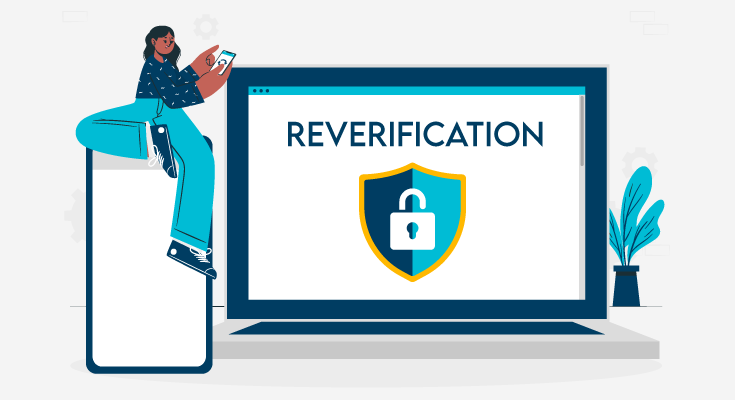The Definitive Guide to Customer Re-Verification

In an era marked by increasing concerns about identity theft, fraud, and regulatory compliance, customer re-verification is becoming incredibly significant. Over time, reverification has become a key aspect of customer KYC and KYB practices. It helps businesses and customers maintain ongoing trust and security in business relationships. While re-verification is essential, it also poses multiple challenges for businesses.
In this comprehensive guide, we will explore everything you need to know about re-verification.
What is Re-Verification?
Re-verification, as the name suggests, is updating and verifying the information of existing customers. The re-verification process makes sure that the customer information a business has is current and accurate.
Re-verification is essential in KYC programs and helps businesses understand the nature of the customers they’re dealing with. Updating customer information regularly makes it easy for businesses to align with regulatory requirements and uphold the integrity of business practices.
Re-verification is also crucial in fighting and preventing online identity fraud. Here are all the benefits of re-verification:
- Prevents Identity Theft – Regularly verifying and updating customer information helps in preventing and fighting identity theft. The process helps businesses ensure that legit individuals are the owners of the account.
- Compliance with Regulations – A number of industries have regulatory requirements for continuous identity verification. The reverification process helps businesses comply with these regulations.
- Enhances Security – Re-verification adds another layer of security to the KYC process. It acts as a proactive measure that helps businesses identify and mitigate potential fraud.
- Strengthen Customer-Business Relationships – Regular verification helps in maintaining trust between customers and businesses.
Essentially, re-verification ensures that the information businesses hold about their customers remains accurate and up-to-date over time.
Challenges of Re-Verifying Customers
The journey of re-verifying customers is fraught with challenges, primarily centered around ensuring the accuracy and comprehensiveness of information. Customer data may have undergone alterations, such as changes in contact details or personal circumstances, complicating the verification process.
Moreover, the sheer volume of customer data that businesses manage can pose logistical challenges, requiring efficient systems and processes to navigate effectively. Additionally, there’s the challenge of striking a balance between thoroughness and customer experience – businesses must conduct rigorous checks while ensuring minimal disruption to their customers’ interactions.
Why is Re-Verification Important for Businesses?
Re-verification stands as a bulwark against the perils of fraud, money laundering, and identity theft, thereby safeguarding the interests of businesses and customers alike. By regularly updating customer information, businesses fortify their security measures and align with regulatory requisites.
Moreover, it fosters trust and confidence among customers, who feel reassured knowing that their information receives ongoing scrutiny and protection. Furthermore, re-verification aids businesses in maintaining accurate customer profiles, which in turn enables targeted marketing, personalized services, and enhanced customer relationship management.
Types of Re-Verification
- Periodic Re-Verification
This involves conducting routine reviews of customer data at predefined intervals, such as annually or biennially, to ensure its currency and accuracy. Periodic reverification helps businesses stay abreast of any changes in customer circumstances and ensures compliance with regulatory requirements.
- Trigger-Based ReVerification
Certain events, such as changes in address, significant transactions, or suspicious activities, may prompt businesses to undertake re-verification exercises to mitigate associated risks. Trigger-based reverification enables businesses to respond swiftly to potential red flags and safeguard against fraudulent activities.
- Enhanced Due Diligence
In scenarios where heightened risks are associated with specific customers or transactions, businesses may adopt more stringent verification protocols to uphold compliance and mitigate risks effectively. Enhanced due diligence typically involves thorough background checks, additional documentation requirements, and closer scrutiny of transactions.
Summary
In summary, re-verification is not merely a regulatory obligation but a crucial safeguard for businesses against fraud and compliance failures. By embracing reverification practices, businesses can maintain the integrity of their operations, foster trust among customers, and navigate regulatory landscapes with confidence.
FAQs
How often should businesses conduct re-verification?
The frequency of reverification may vary depending on factors such as regulatory requirements, risk assessment, and business policies. However, periodic reviews, typically conducted annually or biennially, are common practice to ensure the accuracy and currency of customer data.
What documents are required for re-verification?
The documents required for re-verification may vary depending on jurisdiction and the type of customer. Generally, businesses may request government-issued identification documents, utility bills, or other proofs of address and identity to verify customer information.
What are the consequences of non-compliance with re-verification requirements?
Non-compliance with re-verification requirements can expose businesses to regulatory penalties, reputational damage, and increased risks of fraud and financial losses. It is imperative for businesses to adhere to re-verification procedures to ensure compliance and maintain trust among customers.












